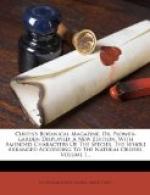LAVATERA (althaeaefolia) foliis infimis cordato-orbiculatis,
caulinis
trilobis acuminatis
glabris, pedunculis unifloris, caule herbaceo.
Miller’s
Gard. Dict. ed. 6. 4to.
MALVA folio vario. Bauh. Pin. 315.
MALVA Hispanica flore carneo amplo.
The Spanish blush Mallow. Park. Parad. p. 366.
[Illustration: No 109]
Our plant is undoubtedly the Spanish blush Mallow of PARKINSON, and the Lavatera althaeaefolia of MILLER according to the former, it is a native of Spain, according to the latter, of Syria.
Mr. MILLER considers it as distinct from the trimestris; Mr. AITON has no althaeaefolia in his Hort. Kew. we are therefore to conclude that the althaeaefolia of MILLER, and the trimestris of LINNAEUS are one and the same species.
Of the annuals commonly raised in our gardens, this is one of the most shewy, as well as the most easily cultivated; its seeds are to be sown in March, on the borders where they are to remain, the plants, thinned as they come up, and kept clear of weeds.
It varies with white blossoms, and flowers from July to September.
[110]
MIMOSA VERTICILLATA. WHORL’D-LEAV’D MIMOSA.
Class and Order.
POLYGAMIA MONOECIA.
Generic Character.
HERMAPHROD. Cal. 5-dentatus. Cor. 5-fida.
Stam. 5. f. plura.
Pist. 1.
Legumen.
MASC. Cal. 5-dentatus. Cor. 5-fida. Stam. 5. 10. plura.
Specific Character and Synonyms.
MIMOSA verticillata intermis, foliis verticillatis
linearibus
pungentibus. L’Herit.
fert. angl. t. 41. Hort. Kew. p. 438.
[Illustration: No 110]
The radical leaves of plants usually differ in shape from those of the stalk, in some plants remarkably so; the Lepidium perfoliatum figured in the Flora Austriaca of Professor JACQUIN is a striking instance of this dissimilarity: the Lathyrus Aphaca, a British plant, figured in the Flora Lond. is still more such, as large entire leaf-like stipulae grow in pairs on the stalk, instead of leaves, while the true leaves next the root, visible when the plant first comes up from seed, are few in number, and those pinnated. The present plant no less admirably illustrates the above remark, the leaves which first appear on the seedling plants being pinnated, as is represented in the small figure on the plate, while those which afterwards come forth grow in whorls. We have observed the same disposition to produce dissimilar leaves in several other species of Mimosa, which have arisen from Botany-Bay seeds, lately introduced.
This singular species, on the authority of Mr. DAVID NELSON, is a native of New South Wales, and was introduced to the royal garden at Kew by Sir JOSEPH BANKS, Bart.




